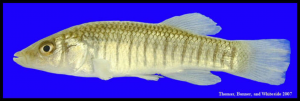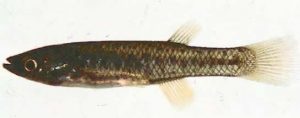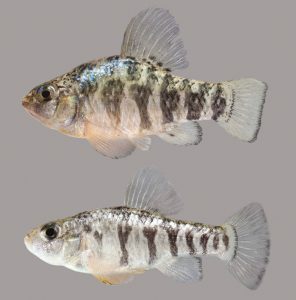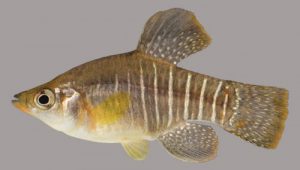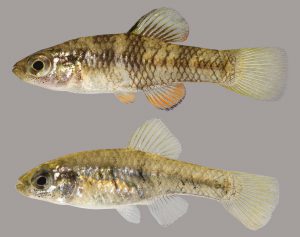Like many of you reading this article, I grew up here in the northern Gulf coast. I spent a lot of time at the beach and in the water enjoying this fantastic place people use to call the “miracle strip” and now call the “emerald coast”. I would spend hours swimming, fishing, crabbing, skiing (a sport that has all but disappeared around here), and just enjoying this place. With all the fishing and snorkeling we did we were familiar with many species in the area. Pinfish, flounder, mackerel, croaker to name a few. But one group of local fish I was not aware of were the killifish. I was not aware of them until I attended Dauphin Island Sea Lab to study marine biology. And then… I discovered them.
Like many who entered marine biology programs in the 1970s I was going to be an ocean going “Jacques Cousteau” studying sharks or something. But at Dauphin Island I was introduced to the amazing world of the estuary where we did a lot of work in Mobile Bay. Pulling seine nets through the numerous salt marshes over there I quickly found that one of the most abundant fish there were these fish known as killifish. They are small minnow type fish who typically run three inches or so in length. There are two who grow larger, the longnose killifish and the gulf killifish both can reach six inches and are known by local fishermen as “bull minnows”. Bull minnows are popular bait, but most fishermen do not know that the actual name of these fish are killifish. When I was in graduate school, I took a course in aquaculture, and we visited five states in five days stopping at federal, state, and private fish farms. One private farm was a “bull minnow” farm in Arkansas. This farmer was doing quite well. He had a collection of corvettes and was working on a collection of mustangs. Needless to say bull minnows are a popular bait.
But who are these abundant estuarine minnows that most are not aware of?
Well, as we said they are small. For most, their bodies are tube shaped (fusiform) and their fins are rounded, not forked. Rounded fins (truncate) are not designed for speed but for better maneuvering in and around grasses, rocks, and coral. Killifish live in the grasses of seagrass beds and shoreline marshes where these fins come in handy.
Most have an extreme tolerance for changes in salinity. The sheepshead minnow (Cyprinodon variegatus) can live in salinities as low as 0 ppt and as high as 100 ppt – mean seawater salinity is 35 ppt. Because of this high tolerance to salinity changes, many of these killifish can be found in a variety of habitats within the estuary and even in freshwater systems entering the bay. One species, the longnose killifish (Fundulus similis) seems to prefer more saline conditions. Because of this we are looking at a local project to determine which estuarine creeks this species is found. The absence of the longnose killifish could suggest freshwater discharge and, possibly, a run-off issue. But with the dramatic salinity shifts typically seen within estuaries due to tides and run-off, having a high tolerance for salinity shifts is a good adaptation to have.
According to Hoese and Moore1 there are seven species of killifish within the estuaries of the northern Gulf of Mexico.
The longnose killifish (Funuduls similis) is elongated with vertical black stripes and a single dot at the base of the tail. It has an elongated snout that gives the name “longnose”. This is a very common killifish but, as mentioned above, disappears when salinities become too low. According to Hoese and Moore1 this fish is not that common along the Gulf coast of peninsula Florida. The biogeographical reason? Not sure. We know this fish does not like freshwater but the discharge in that part of the Gulf is not that different than the panhandle, in fact, it could more saline.
The saltmarsh topminnow (Fundulus jenkinsi) is not as common. Its geographic range extends from Galveston Bay to the western Florida panhandle. Here in Florida, it is so rare it is a listed species. It resembles the longnose in shape and vertical stripes, which are actually rows of black dots, but the snout is short. I am not sure why this fish has not expanded its range east into the Big Bend or west towards Corpus Christi. Both of those areas seem to be higher in salinity and this may be the reason.
The gulf killifish (Fundulus grandis) is the “big boy” of the group. With a mean length of six inches this fish is often confused with “fingerling mullet” and is very popular as bait. This is the fish most often called “bull minnow”. Young will have dark stripes like the longnose but lack the “longnose” and does not have a black spot at the base of the tail. Most lose their stripes when they become older. It is found throughout the Gulf region.
The bayou killifish (Funudulus pulvereus) is another very common killifish in our area. Smaller than the gulf killifish and longnose, it can be identified by the yellowish colored anal fin. Males will have stripes while females will have spots. The coloration of these is amazing and the breeding colors of the males even more so. Hoese and Moore1 report this fish only from southern Texas to Alabama, but we have often found them here in Pensacola. I am not sure how far east they exist, but there must be some barrier in Florida waters to impede their dispersal there.
The sheepshead minnow (Cyprinodon variegatus) is the champion of salinity tolerance. They are found in many estuarine habitats and even some extreme ones where no other fish are found. Hoese and Moore1 report that it has the highest tolerance of any fish in the world. There are records of this fish living in waters over 100 ppt (note: the average salinity for the ocean is 35 ppt). As you might expect, it has the largest range as well. This fish had been reported from Maine, down the entire east coast, the Gulf of Mexico, and as far south as Venezuela. It is not as elongated as most killifish, having a more short and stout appearance. They have dark vertical bars on their bodies and the males produce a beautiful iridescent blue color on their backs during breeding.
The diamond killifish (Adinia xenica) is one that I have not collected very often. It resembles the sheepshead minnow is shape and color but has a more pointed snout and the teeth are compressed instead of conical, as they are in the sheepshead minnow. This fish is restricted to the western Gulf of Mexico but is found here in the Florida panhandle. It usually is in a group with other killifish, so, you would have to look hard in your sample to see if you have it.
Finally, there is the rainwater killifish (Lucania parva). This is a more elongated form with no markings on the body at all. At first glance, after seeing other types of killifish, it would not appear to be a killifish at all. It is one of the smaller killifish (2 inches) and is often found in freshwater creeks feeding into the bays. The males will have a reddish-orange anal fin during breeding season. It does have a large range extending from New England to Mexico.
These are truly amazing fish. They are extremely abundant and hardy. For those prone to use small nets collecting fish along the shorelines, grassbeds, and salt marshes, they will find this group very common, and most do well in aquariums.
Reference
1 Hoese, H.D., Moore, R.H. 1977. Fishes of the Gulf of Mexico; Texas, Louisiana, and Adjacent Waters. Texas A&M Press, College Station TX. Pp. 327.
- Rattlesnakes on Our Barrier Islands; Part 4 – Thermoregulation - December 29, 2025
- Rattlesnakes on Our Barrier Islands; Part 3 – Envenomation - December 22, 2025
- St. Joe Red Tide Claiming Terrapins - December 15, 2025

